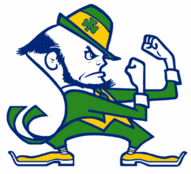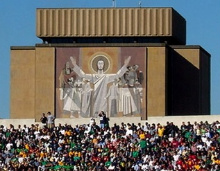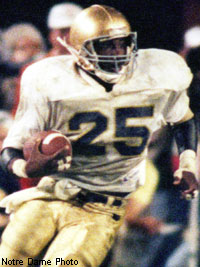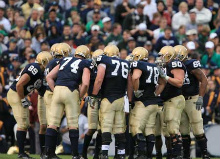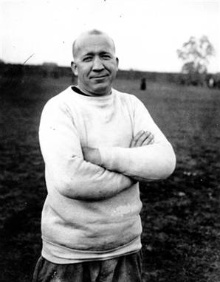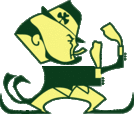The True Story of Knute Rockne, College Football’s Most Renowned CoachThis piece is a dedication to one of the father’s of college football, Knute Rockne. The University is dedicating a bronze statue of their legendary coach on Friday, October 2nd at Notre Dame Stadium.  Rockne coaching the art of football.
This story begins in a municipality of Voors, Norway, a quiet village surrounded by snow-cap mountains, cedar forests, and rivers flowing through valleys. It is here where a young boy, Knute Rocke, was brought into the world on the evening of March 4th, 1888. A mere five months after, the Rockne family made their way across seas to begin a new life in the bustling city of Chicago. Here, young Knute was introduced to the game of American Football in the neighborhood streets. Growing up, Knute had a variety of interests—chemistry being a large one. With his chemistry books and labs in hand, the Norwegian hopped on a train heading to South Bend, Ind. He would spend the next four years of his life at the University of Notre Dame—and then some. He found his way around campus and soon walked into the office of polymer chemist Julis Arthu Nieuwland. Trying to make his name in the world of chemistry, Rockne took the position of laboratory assistant to the famous chemist himself. At the time Rockne attended the university, students were required to participate in a sport. With experience in the game from his high school days at North West Division High, where he played end, it was an easy choice for the underclassman. 1910 marked one of the few times of failure during his life. He was cut from the team for being undersized. One of the turning points in his life, the man never gave up. He used this rejection as a form of motivation, and from 1911 to 1914, he played left-end for the Fighting Irish. Rockne left the university with an undefeated playing record, 22-0-2. The Legend Begins A year after graduation marked the beginning of the greatest coaching career in the history of college football. Jess Harper, whom Rockne played for the previous season, hired him onto the staff as an assistant coach. The two coaches were seemingly opposite of each other—Harper was more mild-mannered while Rockne had a different attitude than anyone before his time. Warnings were not a word in his vocabulary book. He believed players would begin to think warnings did not mean much. Instead, full punishment was given out on the first offense. Off the field, Rockne became a favorite around campus. Players were soon coming to Rockne’s office instead of Harper’s with personal problems because of the close relationships the players had developed so quickly with their new “peer” coach. After a 28-0 defeat, the first Irish loss in four seasons, Harper decided to make a change. He knew Rockne had a football mind like no other, and he used that to the team’s advantage. Before a 1916 game against Wabash, Rockne was asked to fill in for the ill coach. This marked the first time one of Rockne’s famous, fiery pep talks echoed throughout the campus. He ended the emotional talk with, “Now go out there and crucify them!” Notre Dame beat Wabash that day, 60-0. 1918-1930—The Legend Himself At the end of 1917, Harper called “The Swede” into his office. He gave him the news that he wasn’t going to be able to coach the team the next year, and named Knute his predecessor to the job. At 30 years old, Knute Rockne stood on sidelines of Notre Dame Stadium, clipboard in hand and dressed in full uniform, as the head football coach of the Fighting Irish. On his first day on the job, he made his mindset known—and loud: “Win or lose, I´m running this team. Nobody else has anything to say about it´s make-up, it´s plans, it´s type of play. It´s my show. If I flop, let ´em pan me. If we´re a hit, let ´em say anything they want. I worked hard around here as an assistant for many years, and seldom saw my name in print. Well, all I want now is the truth“. From day one, the legend never looked back. During his 13-year career, Rockne posted a record of 105 wins, 12 losses, and five ties. He lead the Irish to five seasons of undefeated football with zero ties. Six of those victories won Notre Dame national championships. His career record gives him the title as college football’s all-time winning percentage leader at 88.1 percent. The Coached Legends Throughout his career, he coached players and turned some into legends themselves. Despite no previous football experience, Rockne recruited George “The Gipper” Gipp to play for his team in 1916. He finished his career with 83 touchdowns and never let a single pass be completed in his protective zone defense. During his four-year career for the Irish, he lifted the program to fame and notoriety. Unfortunately, Gipp’s career was cut short after contracting a serious strep infection in a game against Illinois. He died a few weeks later on December 19th, 1920. In a game that seemed almost un-winnable for his injury-decimated team, Rockne delivered one of the most famous speeches in all of sports, “Win One For the Gipper.” Rockne told his team: “The day before he died George Gipp asked me to wait until the situation seemed hopeless – then ask a Notre Dame team to go out and beat Army for him. This is the day, and you are the team.” “One-Play-O’Brien’s” scored the winning touchdown as the Irish defeated Army, 12-6. Other legends followed in the footsteps of The Gipper. Don Miller, Jim Crowley, Elmer Layden, and Harry Stuhldreher possibly made the greatest mark during Rockne’s time at Notre Dame. After the “Four Horsemen” led a 13-7 upset win over an elite Army team, Grantland Rice put pen to paper and published some of the most famous journalism lines in college football history: “Outlined against a blue-gray October sky, the Four Horsemen rode again. In dramatic lore their names are Death, Destruction, Pestilence, and Famine. But those are aliases. Their real names are: Stuhldreher, Crowley, Miller and Layden. They formed the crest of the South Bend cyclone before which another fighting Army team was swept over the precipice at the Polo Grounds this afternoon as 55,000 spectators peered down upon the bewildering panorama spread out upon the green plain below.” The Death Rockne was scheduled to embark on a two-day visit to Los Angeles following the conclusion of the 1930 season. His visit included participating in the production of The Spirit of Notre Dame and an induction into the famous Los Angeles Breakfast Club. Unfortunately for the icon, he never was able to reach his destination. An early Tuesday morning, March 31st, 1931, Rockne boarded a red and silver Fokker Trimitor airplane in Kansas City. Shortly after takeoff, the aircraft entered a storm and all eight of the passengers on board were killed. At the young age of 43, one of the nation’s most influential and prosperous men in sports had died, which sent the enitre nation into a state of mourning. In recognition of their coach, six of the players Rockne had once coached to perfection carried their idol to his grave site at the Highland Cemetery in South Bend. Since then, Rockne served unofficially as America’s first martyrs of sports. He left our world too early, but not without putting college football on the map due to his genius works on the gridiron and his famous locker room sermons. This remarkable man not only has made a mark on many lives’, mine included, but his legend still survives to this day. I leave you with the words of Rockne that have influenced me the most in life: “Setting a goal is not the main thing. It is deciding how you will go about achieving it and staying with that plan.”
|
||
|
Copyright © 2009 Fighting Irish Gameday - All Rights Reserved |
||
